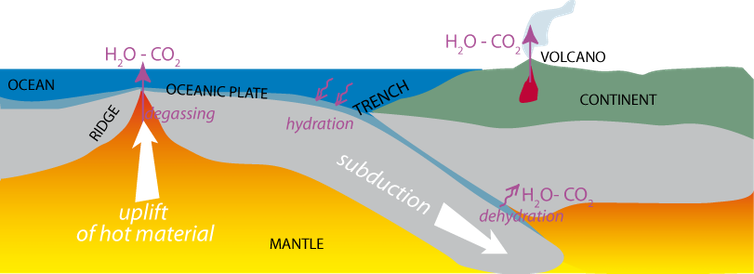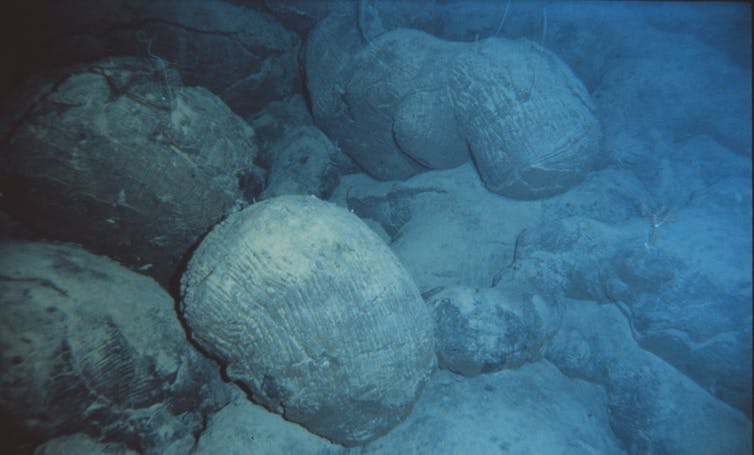Why is the Earth blue?


This article was originally published at The Conversation. The publication contributed the article to Space.com's Expert Voices: Op-Ed & Insights.
Guillaume Paris, Géochimiste, chargé de recherche CNRS au Centre de recherches pétrographiques et géochimiques de Nancy, Université de Lorraine
Laurette Piani, Cosmochimiste, chargée de recherche CNRS au Centre de Recherches Pétrographiques et Géochimiques (CRPG) de Nancy, CNRS, Université de Lorraine
Seen from space, the Earth is blue. The Earth has been blue for over 4 billion years because of the liquid water on its surface. How has the Earth managed to sustain liquid water on its surface for such a long time?
There is only one known planet with permanent bodies of liquid water at its surface: ours. Earth sciences allow us to explain why the Earth has almost always been blue: it’s neither too warm nor too cold. If the Earth was first red and black, it has been blue for more than 4 billion years, with rare exceptions when it got too cold and turned into a white snowball.
This incredible characteristic is due to the interactions of the water cycle with plate tectonics and the greenhouse effect, as well as the configuration of the solar system. Today, Earth’s average surface temperature is about 15°C, colder than Venus (465 °C) and warmer than Mars (-60 °C on average). On Earth, at sea level, water freezes below 0°C and boils at 100°C. Earth’s surface is thus kept within a temperature range that might seem large to us, but is actually fairly narrow when compared with other planets, and it has remained so for billions of years.
Incredible Earth: $22.99 at Magazines Direct
The planet we live on is a remarkable place. But have you ever wondered how or why these things occur? How the Earth was made? How we predict the weather? How fossils form? What causes earthquakes or which animals glow in the dark? "Incredible Earth" reveals answers to these questions and more on a thrilling journey through everything you need to know about our world — and with gorgeous photography and insightful diagrams along the way!
Greenhouse gases play their part
The average temperature on a planet’s surface depends on the interaction of three parameters that can vary widely from one planet to the next:
Breaking space news, the latest updates on rocket launches, skywatching events and more!
- The energy arriving from he Sun.
- The alebedo of the surface, meaning how much it reflects solar radiation away.
- Greenhouse gases, which trap solar radiation within Earth's atmosphere. Without greenhouse gases, Earth's surface would be at a temperature around -15°C and probably devoid of liquid water.
Interactions between sunlight, albedo, and greenhouse gases have maintained a fairly constant energy balance since the first oceans appeared on Earth.
Early in the Earth’s history, the young Sun was less bright and our planet received less energy from it. However, levels of greenhouse gases such as CO2 and methane were much higher than today, which maintained surface temperatures high enough for water to be liquid.
The greenhouse effect decreased over time because CO2 can be removed from the atmosphere by two processes. First, the acidifying effect of CO2 dissolved in surface waters causes rocks to dissolve, which releases calcium. Calcium combines with the dissolved CO2 to form carbonate rocks such as limestone, one of the main carbon sinks.
The second sink is organic carbon stored in sedimentary rocks. Organisms on land and in the ocean use CO2 to build organic matter during photosynthesis, a portion of which is deposited at the bottom of the ocean when the organisms die. There, the organic matter is incorporated into sedimentary rocks, where it can be stored for millions of years.
Without tectonics, no oceans; without oceans, no tectonics
Although carbon sinks store CO2 away from the atmosphere, volcanoes and oceanic ridges deliver CO2 back into the atmosphere. This delivery is sustained through plate tectonics. Over long timescales, plate tectonics helps maintain Earth’s surface temperature in the range that allows surface waters to be liquid. The presence of liquid water and plate tectonics are thus intimately linked. How does that happen?

The ocean floor is composed of oceanic plates. They move away from oceanic ridges, the chain of submarine volcanoes that runs across the planet, and then down toward the depths of the Earth through subduction. During the hundreds of millions of years that they traverse the oceans, oceanic plates become hydrated: their minerals incorporate water, which modifies their mechanical properties. As they are subducted, oceanic plates eventually dehydrate; the released water eventually produces magmas that form granites, the bedrock of the continents. Without liquid water, there would be no tectonics and therefore, no continents!
Due to this recycling of older oceanic plates into the mantle, new plates are constantly being formed from material erupted at oceanic ridges. As this material rises through the mantle and to the ocean floor, it cools and releases CO2, helping sustain greenhouse gas concentrations. Water remains liquid and the Earth remains blue, as it has been for several billion years.
From black and red to blue

It has long been assumed that water-rich celestial bodies from the outer solar system brought water to the recently formed Earth. One of our team recently published a study that questions this hypothesis and suggests that water – that is, hydrogen and oxygen – could have been brought instead by the rocks that formed the Earth.
When the Earth first formed 4.5 billion years ago, it was probably too hot for water to be liquid at the surface. In any case, if there had been oceans, they would certainly have vaporized upon the giant impact between the young Earth and a planetary body (probably as big as Mars), which melted the surface of our planet and formed the Moon 4.4 billion years ago.
As the Earth’s surface slowly cooled and solidified after the impact, it was likely covered in dark basaltic rocks, with neither life nor water. Cooling magmas release elements such as hydrogen, oxygen, and carbon as gas containing molecules such as water, carbon dioxide, and/or methane. The first oceans may therefore have formed relatively quickly after the impact. The first known minerals on Earth bear the chemical signature of interactions with liquid water. Thus, Earth may have been blue for almost 4.4 billion years.
The first indisputable proof of oceans on Earth’s surface is 3.8 billion years old, including the oldest marine sediments, found in Isua and Akilia (Greenland) and Nuvvuagittuq (Canada), and the oldest pillow lavas, uniquely shaped rocks that form as lava cools underwater.

Whether 3.8 or 4.4 billion years old, the history of the oceans is linked to that of the Earth and life. Today, human activities are causing the oceans to become more acidic and warmer. Oceans won’t disappear, but the life within is endangered. Our CO2 emissions exceed global volcanic emissions by a factor of 70, endangering the existing balance between processes operating at the Earth’s surface and those deep within it. Our societies rely on both.
This article is republished from The Conversation under a Creative Commons license. Read the original article.
Follow all of the Expert Voices issues and debates — and become part of the discussion — on Facebook and Twitter. The views expressed are those of the author and do not necessarily reflect the views of the publisher.

